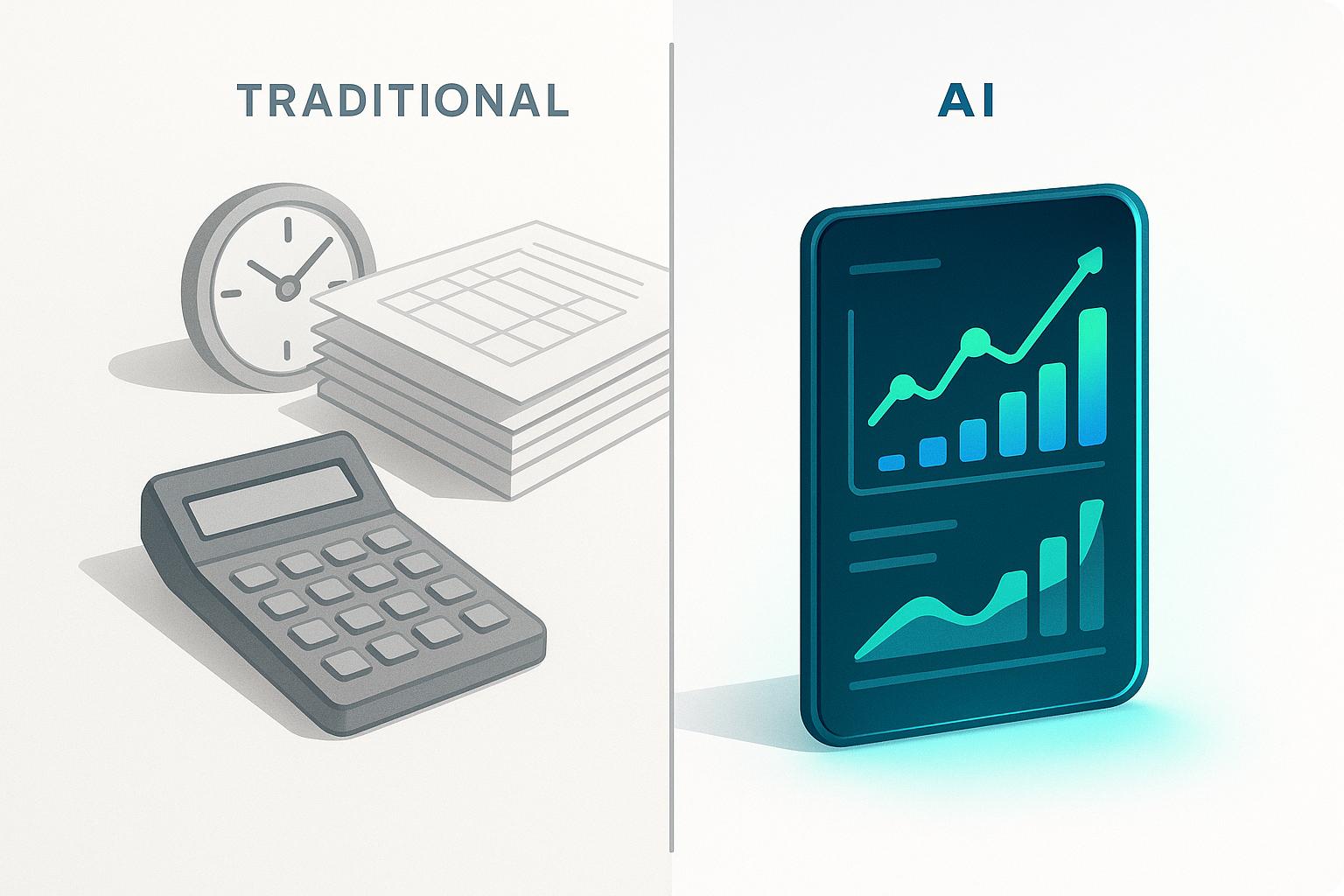AI is transforming how we analyze financial markets by decoding human behavior with unprecedented speed and accuracy. Behavioral market analysis focuses on understanding psychological factors like fear, greed, and sentiment that drive market movements. Traditional methods relied on manual effort and limited data. AI, however, processes vast datasets in real-time, identifying patterns and trends that humans often miss.
Key takeaways:
- Machine learning detects patterns in trading data to predict market movements.
- Natural Language Processing (NLP) analyzes sentiment from news, social media, and earnings calls.
- Real-time data processing identifies anomalies and behavioral shifts instantly.
AI tools are helping businesses make faster, data-driven decisions by combining multiple data streams into actionable insights. This is especially useful for startups, enabling smarter financial planning and risk management through scalable, cloud-based solutions. While AI offers speed and precision, adhering to regulatory and ethical standards is critical for transparency and fairness.
Beyond Surface Insight: How Behavioral AI Uncovers New, Deep Behavioral Insights for Market Research
Core AI Technologies for Behavioral Market Analysis
AI-driven behavioral market analysis hinges on three primary technologies. Each one plays a distinct role in turning raw market data into actionable insights, helping traders and financial strategists make informed decisions. These technologies work together as the foundation of AI's role in reshaping market analysis. Let’s dive into their specific contributions.
Machine Learning for Pattern Detection
Machine learning is the engine behind spotting patterns that humans might miss. Using algorithms like neural networks and deep learning models, these systems analyze historical data to uncover subtle trends that could signal future market movements.
There are two main approaches here:
- Supervised models: These rely on labeled data, linking specific indicators to known outcomes.
- Unsupervised models: These dig deeper, finding hidden patterns that may reveal unexpected behavioral insights.
One standout feature of machine learning is its ability to evolve. As new market data flows in, these models refine themselves, staying in sync with changing conditions and improving their accuracy over time.
Natural Language Processing for Sentiment Analysis
Natural Language Processing (NLP) adds another layer by interpreting the emotional tone behind financial text. Whether it’s analyzing earnings call transcripts, financial news, social media chatter, or regulatory filings, NLP transforms text into insights about market psychology.
Here’s how it works:
- Sentiment scoring: Assigns numerical values to reflect the tone - positive, negative, or neutral - of financial communications.
- Entity recognition: Pinpoints mentions of specific companies, sectors, or instruments.
- Context understanding: Advanced models can grasp nuances like sarcasm or conditional phrasing, making sentiment analysis more accurate.
What’s more, multi-language capabilities allow NLP to assess sentiment across global markets, offering a broad view of how international trends might shape local trading behavior.
Real-Time Data Processing and Anomaly Detection
The ability to process data in real time is crucial for identifying behavioral shifts as they happen. These systems monitor a constant flow of information - from trade executions and order book changes to breaking news and social media updates.
Real-time processing works through:
- Stream processing engines: Handling large volumes of data per second to catch unusual patterns quickly.
- Anomaly detection algorithms: Establishing baseline behaviors and flagging deviations that could hint at significant market changes. These algorithms can also connect seemingly unrelated events to uncover complex trends.
This real-time capability ensures that insights are delivered when they matter most, helping organizations act on current market sentiment and behavioral shifts without delay.
Together, these three technologies - machine learning, NLP, and real-time data processing - form a powerful system for behavioral market analysis. By detecting patterns, interpreting sentiment, and delivering timely insights, they provide traders with the tools they need to stay ahead in a fast-moving financial landscape.
AI Applications in Financial Market Behavior Analysis
AI is revolutionizing how we interpret financial markets, turning raw data into actionable insights. Financial institutions and trading firms are leveraging AI to uncover new ways to understand and react to market dynamics. By tapping into advanced technologies, these tools reveal trading opportunities and potential risks that might otherwise go unnoticed.
Pattern Recognition in Market Behaviors
Using machine learning techniques, AI can identify intricate behavioral markers in market data that might escape even the most experienced human analysts. These systems analyze elements like price movements, trading volumes, order flows, and timing to detect patterns in real time.
For example, technical pattern identification has become more sophisticated, recognizing nuanced variations of classic formations like head-and-shoulders, triangles, and flags. Unlike traditional methods, these systems work in real time, offering traders a significant edge.
AI also uncovers behavioral signatures tied to different types of market participants. For instance, it can distinguish between the smaller, often emotion-driven trades of retail investors and the larger, more systematic activity of institutional players. This distinction provides deeper insight into the forces driving price changes.
Another powerful capability is cross-asset pattern recognition. AI can identify similar behaviors across stocks, bonds, commodities, and currencies, helping traders and portfolio managers understand broader market sentiment shifts. This feature is especially useful during periods of market stress when asset classes often move in tandem.
What sets these systems apart is their ability to adapt. Machine learning models refine their accuracy over time, evolving alongside changing market conditions and trading behaviors.
Sentiment Analysis for Market Trends
Building on natural language processing (NLP) techniques, AI can quantify sentiment intensity and detect rapid tone shifts in financial news and social media, turning these insights into actionable trend forecasts.
With news sentiment analysis, AI processes thousands of financial articles, press releases, and analyst reports in real time. It measures the sentiment across multiple sources, often identifying emerging trends before they manifest in price movements.
Social media monitoring is another crucial application. Platforms like Twitter, Reddit, and financial forums are goldmines for market sentiment, but they also come with a lot of noise. AI filters through this chatter to pinpoint meaningful signals that align with actual market movements.
One of the most intriguing uses is earnings call analysis. AI doesn't just analyze what executives say during these calls - it evaluates how they say it. Shifts in tone, word choice, or vocal stress can reveal management’s confidence levels, offering insights that traditional analysis might miss.
Another valuable tool is regulatory filing analysis. AI scans company filings, such as those submitted to the SEC, for subtle changes in language. These shifts can signal operational challenges or opportunities well before they become apparent to the broader market.
Together, these tools not only help predict market trends but also support real-time decision-making and risk management.
Risk Management and Fraud Detection
AI is also playing a critical role in safeguarding market integrity by identifying risks and detecting fraudulent activities that could disrupt trading.
Through dynamic risk assessment, AI systems continuously monitor portfolio exposure and market conditions, adjusting risk parameters in real time. Unlike static models that rely on historical data, these systems adapt to current market conditions. For example, they can identify when typical correlations between assets are breaking down - a common sign of market stress - and adjust strategies to mitigate potential losses.
Additionally, AI excels at credit and counterparty risk monitoring. By analyzing trading patterns, payment behaviors, and even communication trends, these systems can detect early warning signs of financial distress. This early detection helps firms avoid losses linked to counterparty defaults.
AI also flags anomalies in trading activity, providing early alerts for potential market stress events or fraudulent behavior. This is particularly important for preventing flash crashes and managing credit risks.
sbb-itb-17e8ec9
Benefits and Performance Metrics of AI-Driven Analysis
AI-powered analysis is transforming how trading and investment management operate, offering a level of efficiency and speed that traditional methods struggle to match.
AI vs. Traditional Methods Comparison
Conventional behavioral analysis typically relies on human interpretation and historical models. While these methods have their place, they often fall short when faced with the complexity and speed of modern financial markets. AI-driven analysis, on the other hand, processes massive amounts of data in real time, delivering:
- Faster identification of market signals: AI can detect subtle patterns and trends almost instantly.
- Broader market coverage: It can analyze diverse markets simultaneously, something human analysts can't achieve at scale.
- Consistency: By removing the variability inherent in manual analysis, AI ensures more reliable outcomes.
These capabilities enable traders to react quickly to market shifts, minimizing delays and reducing the risks associated with human error.
Performance Metrics in AI-Driven Trading
AI systems bring measurable improvements to trading performance. Some of the key metrics include:
- Improved accuracy: AI excels at spotting market patterns and executing timely entries and exits, leading to better risk management.
- Operational efficiency: Faster and more precise order execution reduces transaction costs, which directly impacts profitability.
By offering more reliable signals and quicker responses, AI-driven strategies can help achieve stronger risk-adjusted returns and promote steadier long-term performance - an essential goal for any trading operation.
Case Studies and Examples
Practical applications of AI in trading highlight its ability to uncover opportunities that might otherwise go unnoticed. Beyond trading, AI has proven invaluable in areas like treasury forecasting and operational planning. For startups, these benefits are especially critical, as they help conserve capital and support strategic decision-making.
How Startups Can Use AI for Behavioral Market Analysis
Startups need AI solutions that are scalable, cost-effective, and deliver results quickly. Below, we explore the technical setup, compliance needs, and practical applications crucial for startups diving into AI-driven behavioral market analysis.
Infrastructure and Data Requirements
Setting up an AI-powered system for behavioral analysis requires thoughtful planning, especially around infrastructure and access to quality data. Startups should prioritize computing power, reliable data sources, and integration capabilities.
Cloud-based platforms are ideal for startups, offering scalable computing power without the hefty upfront costs of on-premises hardware. This approach allows businesses to start small and expand as their data needs grow.
Data quality is the backbone of effective behavioral analysis. Startups must gather reliable real-time market data, historical price trends, sentiment from news, and insights from social media. Managing both structured and unstructured data requires robust storage and processing systems. Additionally, integrating APIs can connect AI insights directly to existing tools, turning raw data into actionable business intelligence.
Regulatory and Ethical Considerations
Beyond the technical setup, startups must address regulatory and ethical challenges. Adhering to frameworks like those set by the SEC or CFTC is non-negotiable.
To stay compliant, startups should document data inputs and AI model decisions, ensuring transparency during audits. Data privacy is equally critical. While much market data is public, combining it with information from social media or news could introduce personal data elements. Regulations like the California Consumer Privacy Act (CCPA) must guide how this data is handled.
Ethical considerations are just as important. Regularly testing AI systems for bias helps maintain impartiality, protecting market integrity and fostering trust.
Using Lucid Financials for Real-Time Financial Insights

Lucid Financials seamlessly integrates AI-driven behavioral insights into startup finance, offering real-time forecasting that complements market behavior analysis.
One standout feature is its Slack integration, which allows founders to access key financial data instantly. For instance, a founder could ask, "How will a 20% market downturn affect our cash flow?" and receive immediate insights. This kind of real-time feedback supports quicker, more informed decision-making.
Lucid also automates financial reporting, ensuring that market insights directly influence cash flow projections. If AI detects trends that could impact revenue or expenses, Lucid updates forecasts automatically and notifies founders via Slack.
The platform's investor-ready reporting is a game-changer during fundraising. If market sentiment indicates it's a good time to raise capital, Lucid quickly generates updated financial projections and polished reports, helping startups engage investors with confidence.
For startups with multiple business entities, Lucid offers comprehensive tracking and consolidated reporting, making it easier to manage performance across subsidiaries. With pricing starting at $150 per month, it’s designed to grow with your business, offering advanced financial intelligence while staying accessible. By linking real-time financial insights to market behavior, Lucid Financials provides a practical example of how startups can harness AI effectively.
Conclusion
AI has reshaped how we interpret and analyze behavioral patterns in financial markets. By using tools like machine learning, natural language processing, and real-time data analysis, businesses can now pinpoint market trends, gauge investor sentiment, and make decisions grounded in data - quickly and with impressive precision.
This shift to AI-driven methods brings faster processing, sharper pattern recognition, and broader data analysis, giving organizations the ability to detect trends early and gain an edge that traditional methods simply couldn't provide.
For startups and growing companies, AI-powered market analysis levels the playing field. What used to be exclusive to large institutions is now within reach, thanks to cloud-based solutions that are both cost-effective and scalable. Businesses can start small and expand their AI capabilities as they grow, making sophisticated insights more accessible than ever.
That said, success in this space requires a solid foundation. As emphasized earlier, ensuring data quality, adhering to SEC and CFTC guidelines, and addressing ethical concerns like algorithmic bias are critical. Companies that invest in proper systems and maintain ongoing monitoring often see the payoff in more accurate predictions and better risk management.
Taking it a step further, integrating AI-driven behavioral analysis with comprehensive financial platforms - such as Lucid Financials - creates a powerful synergy. When market insights directly influence financial planning, from cash flow projections to investment strategies, businesses can adapt more quickly to market shifts and seize new opportunities.
As AI continues to advance, its potential for behavioral analysis will only grow. The organizations that combine AI-driven insights with human judgment and a commitment to ethical practices will be best positioned to navigate the complexities of financial markets and stay ahead in an ever-changing landscape.
FAQs
How does AI enhance the speed and accuracy of analyzing market behavior compared to traditional methods?
AI has transformed market behavior analysis by leveraging advanced algorithms to process enormous datasets at lightning speed and with impressive precision. Unlike older, more manual approaches, AI can sift through multiple data streams at once, identifying patterns and trends in real time - something that might take humans weeks or even months to accomplish.
By minimizing human errors and providing consistent, dependable insights, AI enhances the accuracy of predictions about consumer behavior and market trends. This empowers traders and analysts to make quicker, data-backed decisions, offering a clear edge in the fast-moving world of financial markets.
What ethical and regulatory factors should startups consider when using AI for market analysis?
Startups using AI for market analysis need to prioritize data privacy and security by adhering to laws like the GDPR and CCPA. Beyond compliance, they must tackle ethical issues, including transparency, fairness, and accountability, ensuring that AI systems are clear in their operations and decisions.
In the financial world, businesses must follow regulations set by bodies like the SEC and FINRA. These rules focus on transparency, accurate recordkeeping, and risk management. Sticking to these standards doesn’t just meet legal requirements - it also strengthens trust among customers and stakeholders, all while encouraging responsible use of AI.
How can startups use AI to improve financial planning and make better decisions?
Startups can take advantage of AI to simplify financial planning by automating tasks such as bookkeeping, expense tracking, and reporting. With real-time insights into their financial status, founders can easily spot trends and patterns while cutting down on tedious manual work.
AI also improves decision-making through predictive analytics, which help forecast risks and opportunities. This means startups can respond quickly, manage resources wisely, and navigate market shifts with ease. By incorporating AI-driven tools into their workflows, startups can dedicate more energy to growth while keeping their financials organized and accurate.


